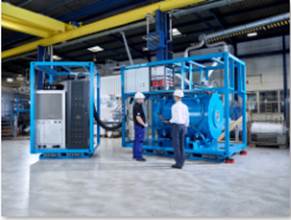Magnetic bottle for antiprotons reaches TU Darmstadt
Core device of PUMA to transport antimatter and study rare isotopes
A core device for the future transport of antimatter has been delivered to Technical University of Darmstadt: The PUMA device will be further prepared for nuclear physics experiments to be conducted at CERN.
The PUMA (antiProton Unstable antiMatter Annihilation) project led by TU Darmstadt aims at storing and transporting antiprotons, the antiparticle of the proton, to be used as a new probe for investigating the structure of radioactive nuclei at ISOLDE / CERN. The project, gathering about 40 collaborators from 13 different research institutes and universities, is currently being evaluated to become a new CERN experiment.
Antiprotons will annihilate if they get in contact with matter. To store antimatter particles and prevent them from annihilation, they can be stored in an electromagnetic bottle called a Penning trap. The main apparatus of the PUMA experiment is the superconducting solenoid which provides the strong magnetic field to confine radially the charged particles.
PUMA is the first cryogen-free magnet ever built to transport antimatter on the road. The superconducting magnet with a weight of 4 metric tonnes is designed to be moved by crane and truck while operating at 4 T magnetic field.
The solenoid and its integration into a transportable frame were contracted to Bilfinger Noell GmbH, Würzburg.
Bilfinger Noell, based in Würzburg, is a company of Bilfinger SE and offers special solutions and high-tech special machinery. Its strengths are innovative solutions through the use of efficient technologies, whether in research or power engineering. The focus is particularly on applications in nuclear, cryogenic, magnetic, vacuum and superconducting technology. Bilfinger Noell’s range of services includes the development, planning, delivery and commissioning up to the operation of delivered systems and their facilities. The approximately 300 employees are mainly active in the field of engineering.
After successful factory testing, the solenoid was delivered to TU Darmstadt and transported to the experimental hall at TU Darmstadt.
The magnet provides a uniform 4 tesla magnetic field, about 100,000 times the strength of the earth’s magnetic field, across a cylinder of 1 meter length with a diameter of 28 cm, where the experimental devices will be placed. The magnetic field is created by a current of almost 200 A flowing through superconducting NbTi wires. The superconducting wires are maintained at cryogenic temperature of below 4 K by two cryocooler heads without the need of any liquid helium or nitrogen. The solenoid is actively and passively shielded such that the residual field drops to 3 Gauss in less than 2 meters away from the solenoid, keeping a low magnetic field environment for the surrounding instruments.
The full experiment can be transported in operation with its uninterruptible power supply (UPS) and battery set providing 80 kW for several minutes. The team of the group of Prof. Alexandre Obertelli at the physics department of the TU Darmstadt started the R&D for PUMA. First experiments at CERN are planned in 2022. PUMA will quantify the neutron excess at the surface of nuclei, important to understand interactions between protons and neutrons in nuclei and the nuclear equation of state, that is driving the structure of neutron stars.
The press release TU Darmstadt can be found here: https://idw-online.de/de/news760233

PUMA workshop picture at Bilfinger Noell
Artikel lesen
